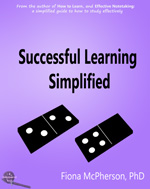When you evaluate any specific study strategy the critical questions are:
- Does it help you understand the information?
- Does it help you select the important information?
To choose a strategy, you must assess the situation. In this case, this may mean an evaluation of a written text. Let's look at how you might evaluate text.
We can classify text at one of three different levels, according to its structure and density1:
- simple (straightforward text with clear connections)
- complex (characterized by many changes of topic and more than one level of information)
- difficult (dense text with many topic changes, often unclear, inconsistent and/or abstract)
These different types of text require progressively more complex strategies.
Textual strategies can be classified into six broad processes1:
Broad processes |
Specific strategies |
| Re-stating | paraphrasing; visualizing; transformational elaboration |
| Selecting | underlining, highlighting, boxes, lists |
| Abstracting themes | headings, summaries |
| Perceiving structure | outlines, graphic organizers |
| Making sense of information | elaborative interrogation, analogies, maps, multimedia summaries, re-structuring, charts & tables, integrating sections of text. |
| Monitoring comprehension | constructing and testing theories about the meaning of the text, seeking additional information |
Matching these processes against our classes of text (noting that processes listed beside text levels indicate additional processes required - including processes used at lower levels of difficulty), we get1:
| Simple text | re-statement |
| Complex text | selecting abstracting themes perceiving structure making sense of information |
| Difficult text | monitoring comprehension |
References
- Jones, B.F. 1986. Text learning strategy instruction: guidelines from theory and practice. In C.E. Weinstein, E.T. Goetz & P.A. Alexander Learning and study strategies. New York: Academic Press.
- 1. Taken from The Memory Key.
